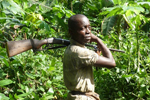Counting wildlife may sound straight-forward, but achieving accurate estimates has plagued scientists for centuries, especially in difficult and dense environments like rainforest. Recently, one method to estimate leaf-eating primates was to look at leaf quality in a particular habitat, particularly the ratio of protein to fiber in leaves. However, a new study in mongabay.com’s open access journal Tropical Conservation Science adds to growing concerns regarding this model by finding that it doesn’t accurately predict abundance of red colobus (Procolobus rufomitratus) in Uganda’s Kibale National Park.
“A clear understanding of the factors influencing animal abundance and distributions is critical for the development of informed conservation and management plans,” the researchers write.
A recent theory has proposed that “protein-to-fiber ratio of leaves was an important criterion for leaf selection by primates, whereby leaves with higher protein-to-fiber ratios were selected over those with lower ratios.”
To test this idea, scientists measured abundances of red colobus in regenerating forest in Kibale National Park. The protein-to-fiber model would predict that birth rates would be higher in regenerating forest than primary forest, given “access to higher quality foods.”
However, the researchers found “no differences in the female to infant ratio, regardless of whether or not juveniles were included in the infant class. Similarly, group size did not differ among groups with access to regenerating forest and those without access.” The findings are in line with other recent studies that have also questioned the accuracy of the protein-to-fiber model. But this leaves primatologists with the questions: what other drivers are involved in primate abundance?
CITATION: Gogarten, J. F., Guzman, M., Chapman, C. A., Jacob, A. L., Omeja, P. A., and Rothman, J. M. 2012. What is the predictive power of the colobine protein-to-fiber model and its conservation value? Tropical Conservation Science. Vol. 5(3):381-393.
Related articles
Remarkable new monkey discovered in remote Congo rainforest

(09/12/2012) In a massive, wildlife-rich, and largely unexplored rainforest of the Democratic Republic of the Congo (DRC), researchers have made an astounding discovery: a new monkey species, known to locals as the ‘lesula’. The new primate, which is described in a paper in the open access PLoS ONE journal, was first noticed by scientist and explorer, John Hart, in 2007. John, along with his wife Terese, run the TL2 project, so named for its aim to create a park within three river systems: the Tshuapa, Lomami and the Lualaba (i.e. TL2), a region home to bonobos, okapi, forest elephants, Congo peacock, as well as the newly-described lesula.
Turning gorilla poachers into conservationists in the Congo [warning: graphic photos]

(08/13/2012) Although founded only four years ago, Endangered Species International-Congo, has ambitious plans to protect dwindling Western gorilla populations and aid local people in the Republic of the Congo. The organization, an offshoot of Endangered Species International (ESI), has been spending the last few years studying the bushmeat trade in Pointe-Noire, the country’s second largest city, and developing plans for turning hunters into conservationists.
First pictures of newly discovered monkey in China published
(07/27/2012) Researchers have published the first evidence that a recently discovered monkey ranges into China, releasing pictures of the Rhinopithecus strykeri snub-nosed monkey in its natural habitat in Yunnan province. The photos are published in the current issue of the American Journal of Primatology.







